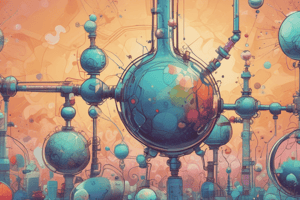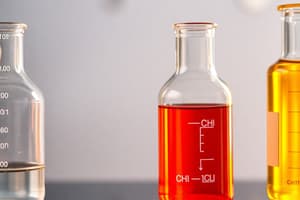Podcast
Questions and Answers
Which type of catalysis involves a catalyst and reactants in the same phase?
Which type of catalysis involves a catalyst and reactants in the same phase?
- Homogeneous catalysis (correct)
- Heterogeneous catalysis
- Enzyme catalysis
- Biocatalysis
What is a characteristic of heterogeneous catalysis?
What is a characteristic of heterogeneous catalysis?
- High selectivity
- Difficult separation from the reaction mixture (correct)
- Operative under mild conditions
- Same phase between catalyst and reactants
Which biochemical compound is primarily involved in enzyme catalysis?
Which biochemical compound is primarily involved in enzyme catalysis?
- Proteins (correct)
- Carbohydrates
- Lipids
- Nucleic acids
Which type of catalysis is known for its high activity and selectivity?
Which type of catalysis is known for its high activity and selectivity?
What is a characteristic of homogeneous catalysis?
What is a characteristic of homogeneous catalysis?
Which type of catalysis is characterized by low environmental friendliness?
Which type of catalysis is characterized by low environmental friendliness?
What is a characteristic of enzyme catalysis?
What is a characteristic of enzyme catalysis?
Which type of catalysis is more eco-friendly and easy to handle?
Which type of catalysis is more eco-friendly and easy to handle?
What is the primary characteristic of homogeneous catalysis?
What is the primary characteristic of homogeneous catalysis?
Which type of catalysis is characterized by the catalyst existing in a different phase than the reaction mixture?
Which type of catalysis is characterized by the catalyst existing in a different phase than the reaction mixture?
What is the advantage of heterogeneous catalysis in terms of separation from the reaction mixture?
What is the advantage of heterogeneous catalysis in terms of separation from the reaction mixture?
Which type of catalysis is known for its high activity and selectivity?
Which type of catalysis is known for its high activity and selectivity?
What is the difference between reactants and catalyst in homogeneous catalysis?
What is the difference between reactants and catalyst in homogeneous catalysis?
What is the environmental impact of homogeneous catalysis?
What is the environmental impact of homogeneous catalysis?
What is the characteristic of the catalyst in heterogeneous catalysis?
What is the characteristic of the catalyst in heterogeneous catalysis?
What is the purpose of biochemical catalysts in the body?
What is the purpose of biochemical catalysts in the body?
What is the major reason for the slow reaction between S2O82- and 2Fe2+ in water?
What is the major reason for the slow reaction between S2O82- and 2Fe2+ in water?
What is the role of Co2(CO)8 in the carbonylation of methanol?
What is the role of Co2(CO)8 in the carbonylation of methanol?
What is the product of the hydrolysis of nitramide in the presence of OH- ions?
What is the product of the hydrolysis of nitramide in the presence of OH- ions?
What is the role of NO in the oxidation of SO2?
What is the role of NO in the oxidation of SO2?
What is the catalyst used in the Freidel-Craft's reaction?
What is the catalyst used in the Freidel-Craft's reaction?
What is the purpose of using iron(II) as a catalyst in the reaction between S2O82- and 2Fe2+?
What is the purpose of using iron(II) as a catalyst in the reaction between S2O82- and 2Fe2+?
What is the role of chlorine in the decomposition of ozone?
What is the role of chlorine in the decomposition of ozone?
What is a characteristic of homogeneous catalysis?
What is a characteristic of homogeneous catalysis?
What is the common feature of the mechanisms of the catalyzed reactions mentioned in the text?
What is the common feature of the mechanisms of the catalyzed reactions mentioned in the text?
What phase do the reactants and catalyst exist in for heterogeneous catalysis?
What phase do the reactants and catalyst exist in for heterogeneous catalysis?
Which type of catalysis is known for its high activity and high selectivity?
Which type of catalysis is known for its high activity and high selectivity?
What is the phase of the catalyst in most heterogeneous catalysis?
What is the phase of the catalyst in most heterogeneous catalysis?
Which of the following catalysis types involves reactants and the catalyst in the same phase?
Which of the following catalysis types involves reactants and the catalyst in the same phase?
What is the characteristic of enzyme catalysis in terms of selectivity and activity?
What is the characteristic of enzyme catalysis in terms of selectivity and activity?
What is the result of the breakdown of ozone molecules?
What is the result of the breakdown of ozone molecules?
What is the role of the catalyst in homogeneous catalytic processes?
What is the role of the catalyst in homogeneous catalytic processes?
What is the theory that explains the mechanism of catalytic reaction?
What is the theory that explains the mechanism of catalytic reaction?
What is the equation that represents the acceleration of the catalytic reaction?
What is the equation that represents the acceleration of the catalytic reaction?
What is the effect of a reduction in activation energy of 10 Kcal/mol in a catalytic reaction at 300K?
What is the effect of a reduction in activation energy of 10 Kcal/mol in a catalytic reaction at 300K?
What is the intermediate compound formed in the catalytic reaction?
What is the intermediate compound formed in the catalytic reaction?
What is the final product formed in the catalytic reaction?
What is the final product formed in the catalytic reaction?
What is the characteristic of the activated complex formed in the catalytic reaction?
What is the characteristic of the activated complex formed in the catalytic reaction?
Flashcards are hidden until you start studying
Study Notes
Types of Catalysis
- There are three classes of catalytic reactions: homogeneous catalysis, heterogeneous catalysis, and enzyme catalysis (biocatalysis).
Homogeneous Catalysis
- The catalyst is in the same phase as the reaction mixture.
- Characterized by high selectivity and high activity with maximum selectivity.
- Operates under mild conditions, i.e., thermal unstable.
- Difficult separation from the reaction mixture and reutilization of the catalyst is less possible.
- Less environmental friendly due to the formation of toxic products.
- Examples include:
- Reaction between persulphate and iodide ions
- Carbonylation of methanol
- Hydrolysis of nitramide in presence of OH- ions
- Oxidation of SO2 in presence of NO
- Decomposition of H2O2 in presence of dichromate
- Freidel-Craft's reaction
- Decomposition of ozone (hole of ozone)
Heterogeneous Catalysis
- The catalyst acts in a different phase than the reaction mixture.
- Characterized by relatively high activity with perhaps low selectivity.
- Most heterogeneous catalysts are solids that act on reactants in a liquid or gaseous reaction mixture.
- Easy separation from the reaction mixture and reutilization of the catalyst is possible.
- Eco-friendly, easy to handle, and can be operated at strong reaction conditions.
- Most heterogeneous catalysts are solids acting on reactants in a liquid or gaseous phase.
Enzyme Catalysis (Biocatalysis)
- Biochemical catalysts are helpful to speed up biochemical reactions in the body.
- Made up of proteins.
- Characterized by high activity and selectivity.
- Low environmental impact.
- Primarily consists of proteins.
Key Concepts
- The theory of activated complex (intermediate compound theory) can be used to explain the mechanism of the catalytic reaction.
- The catalyst converts the reactant into an unstable intermediate (a high reactive state).
- An activated complex is formed due to the interaction between the intermediate compound and the second reactant.
- The unstable activated complex is relatively slowly dissociated to the final reaction product.
- The catalytic reaction will be accelerated by a reduction in activation energy.
- The rate of reaction can be accelerated by a factor of 2.05 x 10^7 times for a reduction in activation energy of 10 Kcal/mol in a catalytic reaction at 300K.
Studying That Suits You
Use AI to generate personalized quizzes and flashcards to suit your learning preferences.




